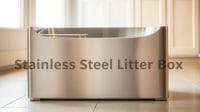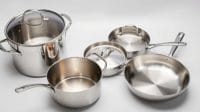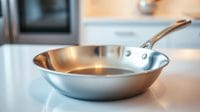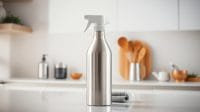Can the right pan really save you time and money in the kitchen?
This guide answers that question with data, hands-on tests, and clear advice. Editors tested searing, heat mapping, time-to-boil, and warping to rank real performance. The result: durable models like All-Clad D3 held up for years, while budget options sometimes warped under high heat.
Readers will find criteria that matter: even heating, responsiveness, warp resistance, induction and oven safety, handle comfort, and lid fit. The guide covers single pans and full sets, and it explains when a set beats buying pieces one by one.
Along the way, expect practical tips on care—hand-wash, mild soap, and Bar Keepers Friend for stubborn marks—and a plain view of price versus long-term value. The section previews top picks like All-Clad D3 and Goldilocks and helps first-time buyers and pros choose what fits their routine.
Why Stainless Steel Pans Belong in Every Kitchen
Good metal pans turn high-heat sears and quick reductions into repeatable results.
Browning and sauce work: Stainless steel outperforms nonstick cookware for building fond—the browned bits that make pan sauces sing. That deeper sear on steaks, chicken thighs, or salmon also tolerates vigorous stirring and deglazing, which yields richer gravies and smooth emulsions like beurre blanc.
Sensible heat control and durability
Fully clad designs respond fast to changes in heat, so reductions are easier to manage. They take frequent high-heat use and metal utensils without immediate wear. Minor discoloration is cosmetic; hand-washing preserves finish and lifespan.
Compatibility and practical toolkit
Many lines work on induction ranges and handle oven finishing at high temps—useful for searing then roasting. A practical kitchen will pair a reliable stainless workhorse with a single nonstick egg pan to cover delicate tasks.
- Use: preheat, add oil, then food—wait for browning before flipping.
- Benefit: better fond, stronger sears, longer life than many coated pans.
Our Top Picks at a Glance
Here are the practical picks that performed best in searing, heat tests, and everyday use.
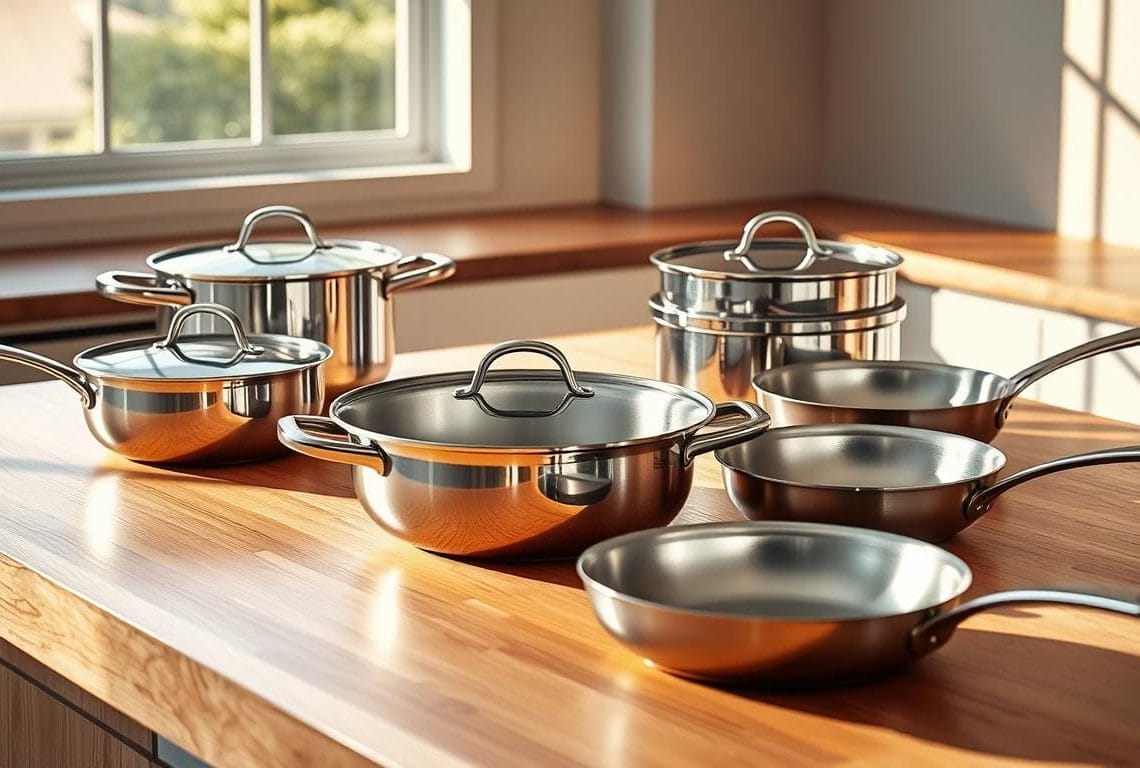
All-Clad D3 Fry Pan — Best overall frying pan
Why choose it: Even heat, warp resistance, and long-term durability make this pan a staple in pro and test kitchens.
Goldilocks Skillet — Best budget stainless steel pan
Why choose it: A responsive tri-ply skillet that’s lighter in hand and very usable day to day at an approachable price.
All-Clad D3 Set — Best cookware set
Why choose it: Consistent performance across saucepans, a sauté pan, stockpot, and skillets—ideal for buyers who want a cohesive stack.
Goldilocks 7-Piece — Best basic 7-piece cookware set
Why choose it: Essentials covered with flared rims and stay-cool handles—an efficient starter 7-piece cookware option for everyday tasks.
- Selection tip: Want pro-leaning consistency and longevity—choose All-Clad; want essentials on a budget—choose Goldilocks.
- Value vs. price: All-Clad’s premium cost often pays off for frequent cooks through years of reliable use.
- Kitchen size: Buy a single standout pan first or commit to a set for uniform performance across the range.
Note: Some mid-tier alternatives showed uneven heat or warping in tests and thus were not recommended.
Top Stainless Steel Cookware
Deciding whether to buy one high-quality pan or an entire matched collection depends on kitchen goals and budget.
Who this roundup serves:
- First setups — a compact 7-piece set covers essentials for small kitchens.
- Targeted upgrades — replace a worn skillet or add a reliable 10–12″ pan for better sears.
- Pro-leaning home cooks — invest in premium pieces for consistent, restaurant-grade results.
Single pans vs a set:
Start with one standout pan if money or space is tight. A great skillet handles most searing and pan-sauce work.
Choose a cohesive set when replacing many worn pieces: sets often save per piece and give matched lids and feel. Serious Eats and our tests show All-Clad D3 performs reliably as a full collection, while Goldilocks’ 7-piece is a solid essentials value pick.
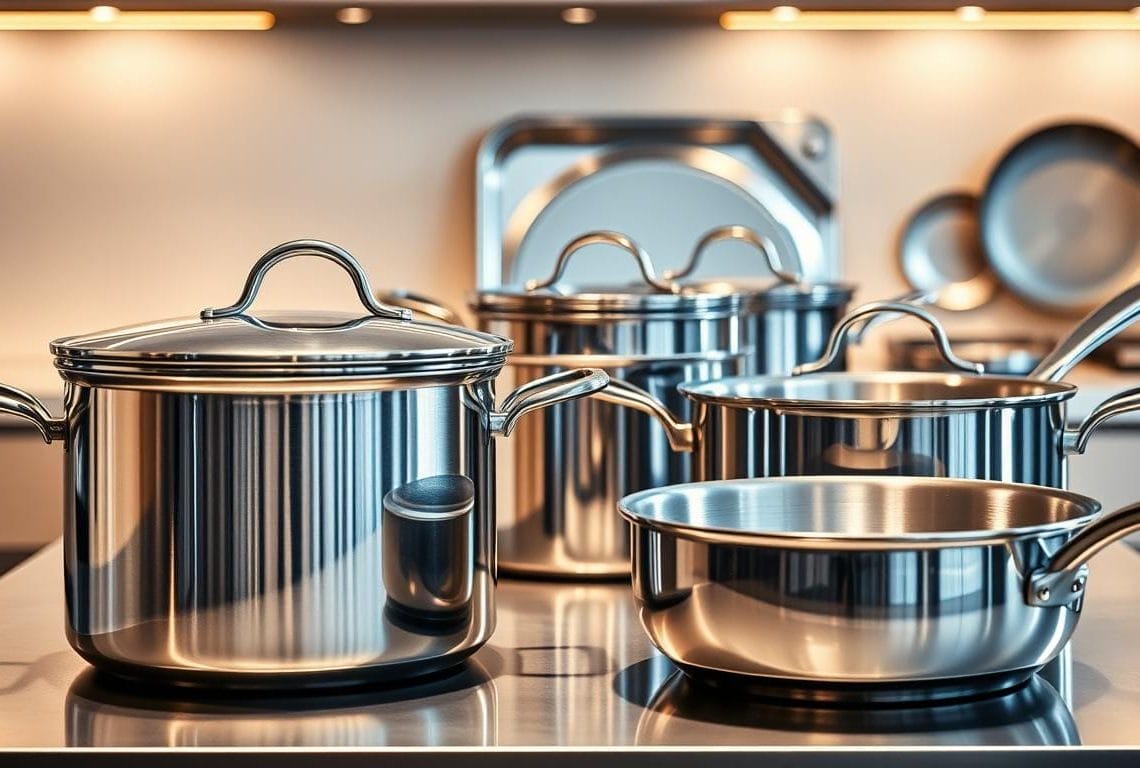
Audit current gear: keep what works, fill gaps, and check warranties on premium brands before buying a whole collection.
Deep Dive: All-Clad D3 Frying Pan Performance
Performance tests show the D3 skillet excels where even, predictable heating matters most. All-Clad’s tri-ply stainless construction sandwiches an aluminum core between two stainless layers to move heat quickly and control it precisely.
Heat mapping demonstrates the across surface temperature is remarkably uniform. That means edge-to-edge browning without hunting for hot spots. In practice, sears and reductions behave the same in the center as at the rim.
Cooking trials confirmed the claims: omelets release after proper preheat and fat; pan sauces deglaze and emulsify cleanly; chicken thighs crisp and render evenly; salmon skins sear without tearing when dried and placed cold onto a hot pan.
The pan’s large flat base and gently sloped rims improve contact and make pouring sauces easier. The 10- and 12-inch skillet sizes balance surface area and wrist comfort—12-inch for batch searing, 10-inch for daily eggs and quick sautés.
Care and longevity: Oven-safe to 600°F and built to last for years, the D3 is dishwasher-safe on paper but benefits from hand-washing. Use mild soap and occasional Bar Keepers Friend to maintain finish and avoid edge wear.
- Ergonomics: sturdy handle for leverage and control.
- Warranty: limited lifetime coverage supports long-term use.
- Buying tip: choose size based on protein volume and cooktop space.
Best Budget Pick: Goldilocks Stainless Steel Skillet
For cooks watching their budget, one skillet delivers a lot of performance per dollar. The Goldilocks 10- and 12-inch models offer a responsive tri-ply stainless steel core and a broad cooking surface area that suits everyday tasks.
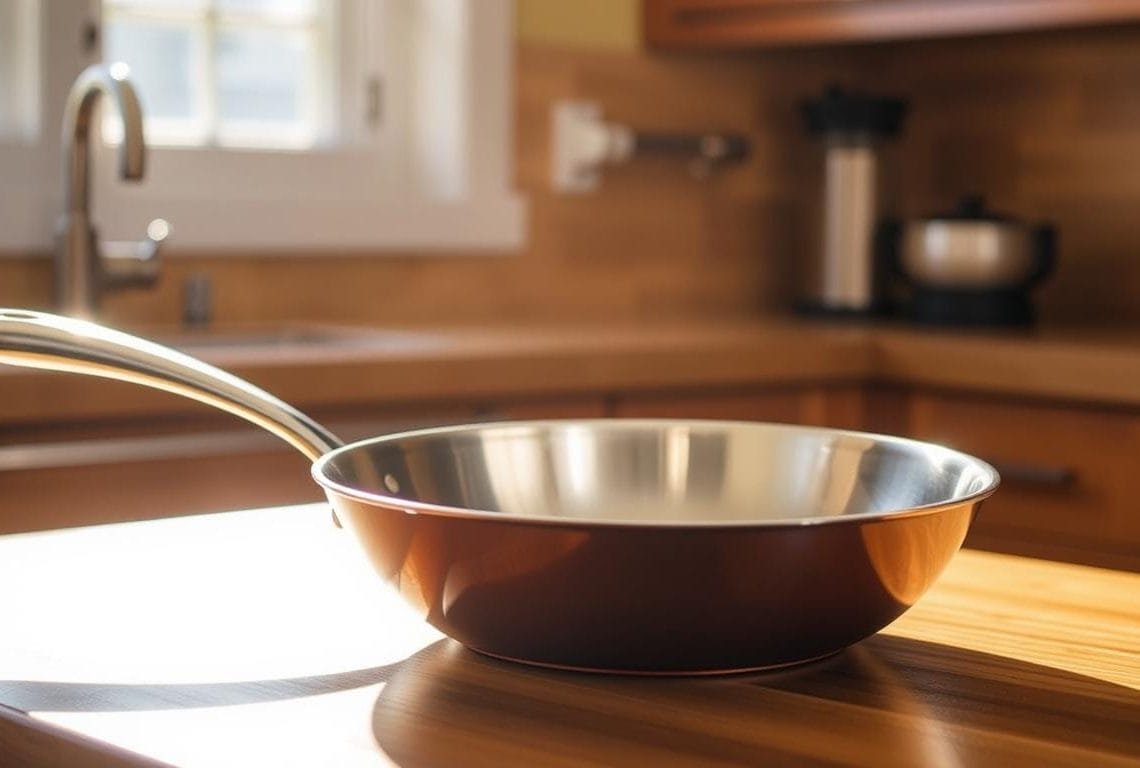
What you get at a low price
Value: A lighter, tri -ply pan that heats quickly and spreads warmth across most of the base. The curved lip aids clean pouring, and the weight makes tossing and transfers easier for one-handed work.
Tradeoffs to consider
Heat behavior: The pan is more responsive to burner changes, but it can scorch faster at very high heat—monitor during long sears. Expect mild bronzing or rainbow discoloration over time; these are cosmetic and removable with Bar Keepers Friend.
- Good for: caramelizing onions, browning chicken thighs, quick pan sauces.
- Oven-safe to 550°F: supports sear-and-finish routines.
- Handle: lightweight grip divides opinion—try before you buy if possible.
Who should buy it: Budget-minded cooks, renters, and small kitchens that need a versatile daily driver or a starter set. Compared with premium options, it’s slightly more prone to scorching but offers strong value for the price.
Best Stainless Steel Cookware Sets Worth Buying
A full set can save money per piece while delivering uniform cooking across pans and pots. A matched collection gives consistent lids, handles, and heat response right away.

All-Clad D3 Set
Why buy: Serious Eats testing shows the All-Clad D3 set holds even heat and resists warping over years. Pieces remain flat, induction-ready, and oven-safe to 600°F.
Performance edge: The tri-ply construction tightens heat spread as the set breaks in—ideal for delicate sauces and repeatable sears.
Goldilocks 7-Piece
Why buy: The Goldilocks 7-piece cookware set covers essentials with flared rims and stay-cool handles. It’s a practical 7-piece cookware option for kitchens on a budget.
Tradeoffs: Faster boiling and wider edge-to-center swings at high heat mean cooks should watch for hot spots during long sears.
When a set beats à la carte
- Lower price per piece and matched lids—better value for new kitchens.
- Uniform pan geometry, flat bases, and consistent handle ergonomics—less guesswork at the stove.
- Mix-and-match tip: add one premium 12-inch skillet to amplify searing without replacing the whole set.
How We Test for Even Heat and Real-World Cooking
We run a compact battery of kitchen trials that reveal true differences in heat and handling.
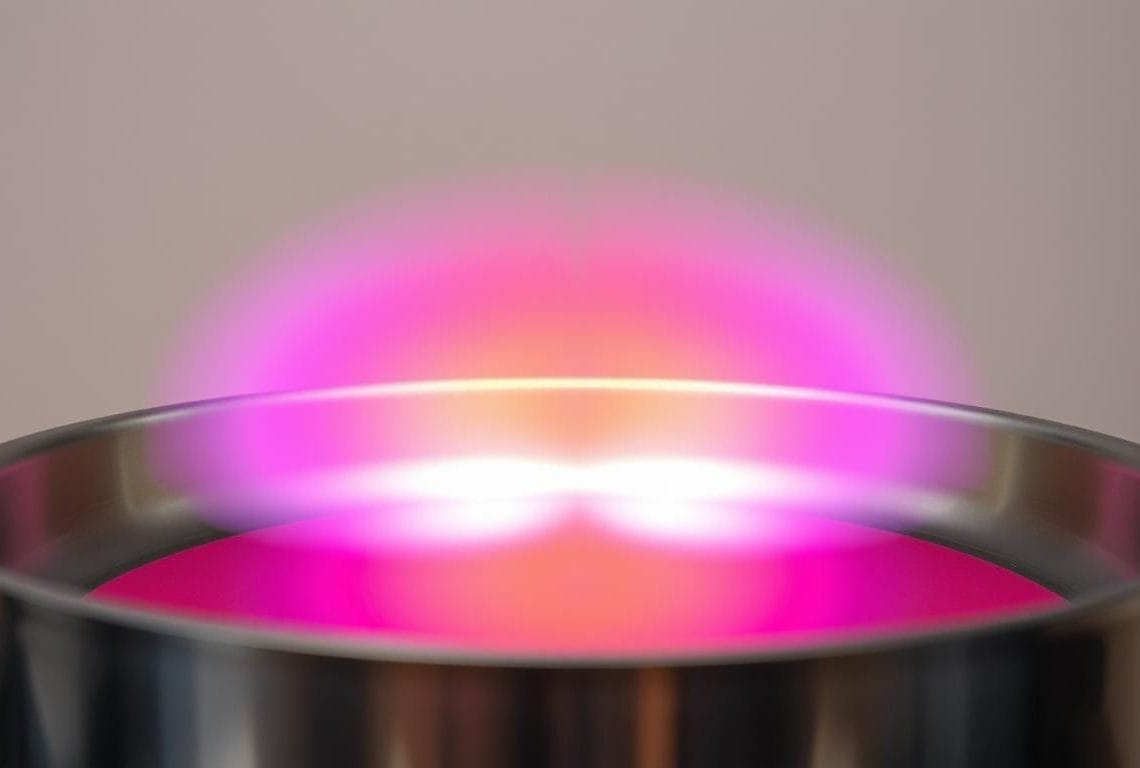
Heat mapping and the flour test
Flour tests expose uneven browning immediately. The team scatters a thin dusting of flour on a preheated skillet and watches where it darkens first.
We pair that visual check with infrared thermometry—readings at center and edges every 30 seconds for four minutes—to chart heat distribution and detect evolving hot spots.
Boiling speed and steak sears
Time-to-boil uses 4 cups of 75°F water. Faster boil times indicate better heat conduction and thicker cores.
For searing, a NY strip is used to assess Maillard depth and edge-to-center browning. Notes record crust release and whether the meat sticks or flips cleanly.
Sticky situations: onions, chicken, and fond
Caramelizing onions and pan-frying chicken thighs highlight where sugars and proteins latch. Tests check how easily fond deglazes into sauce after a splash of liquid.
Cleanup, ergonomics, and stability
Hand-wash trials log residue, rainbow staining, and whether Bar Keepers Friend restores luster. Inspect rivet areas for trapped gunk.
Ergonomics: assess handle comfort, weight balance, helper handles, and lid fit. We also watch for warping that causes wobble on flat cooktops.
- Compare brands: which skillets heated evenly from start to finish.
- Scorecards translate lab data into practical advice—who needs a premium set and who can accept minor hot spots for savings.
What Makes Great Tri-Ply and Clad Stainless Steel
Not all multi-layer pans behave the same; build matters for sears, sauces, and simmering.
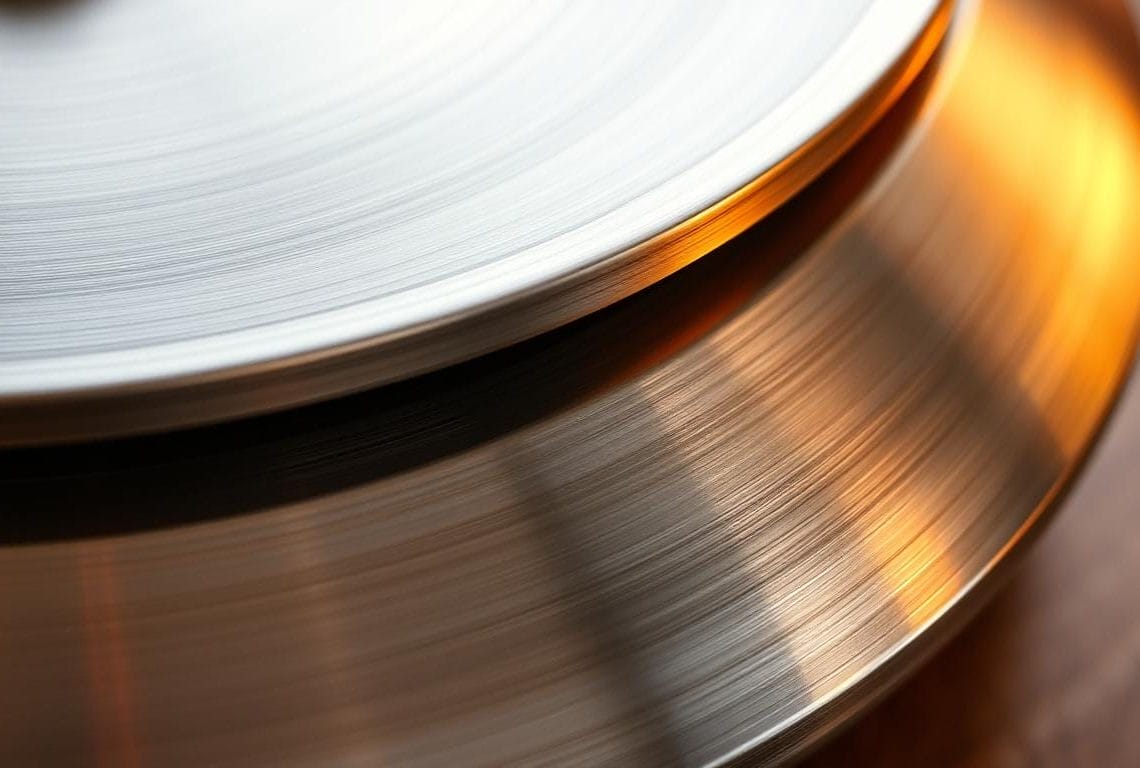
Construction and responsiveness
Define tri-ply: two outer layers of stainless steel sandwich an aluminum core. This tri-ply stainless steel design balances speed, control, and durability for everyday searing and sauces.
Layer choices: 5-ply and copper core
5-ply adds mass for heat retention but can be slower to respond to burner changes. Copper-core options heat very quickly and feel sensitive, yet many copper-clad sets lack induction compatibility and limit oven temps to about 450°F.
Why aluminum matters
Aluminum spreads heat across the surface to reduce hot and cold patches. Good heat conduction yields more even heat and better heat distribution for browning and emulsions.
Geometry, handles, lids
Wide, flat bases maximize contact; flared rims aid pouring and curved walls help whisking. Choose rounded, comfortable handles and sturdy helper grips for safe oven transfers. Tight metal lids hold up in high heat better than low-temp glass.
- Practical pick: tri -ply for all-purpose use; consider 5-ply when you want extra thermal mass for long braises.
- Weight note: avoid builds so heavy they slow response or tire wrists.
- Result: a stable tri-ply pan often sears more evenly, keeps sauces emulsified, and eases cleanup—ideal when selecting a set or single piece of steel cookware.
Sizing Smarts: From Fry Pan to 7-Piece Cookware Set
A well-chosen kitchen lineup trims prep time and reduces clutter at the stove.
Start with the essentials: a 10–12″ skillet, a 1.5–3 qt saucepan, and an 8‑quart stockpot cover most weekly meals. This trio handles searing, sauces, and boiling without excess storage needs.
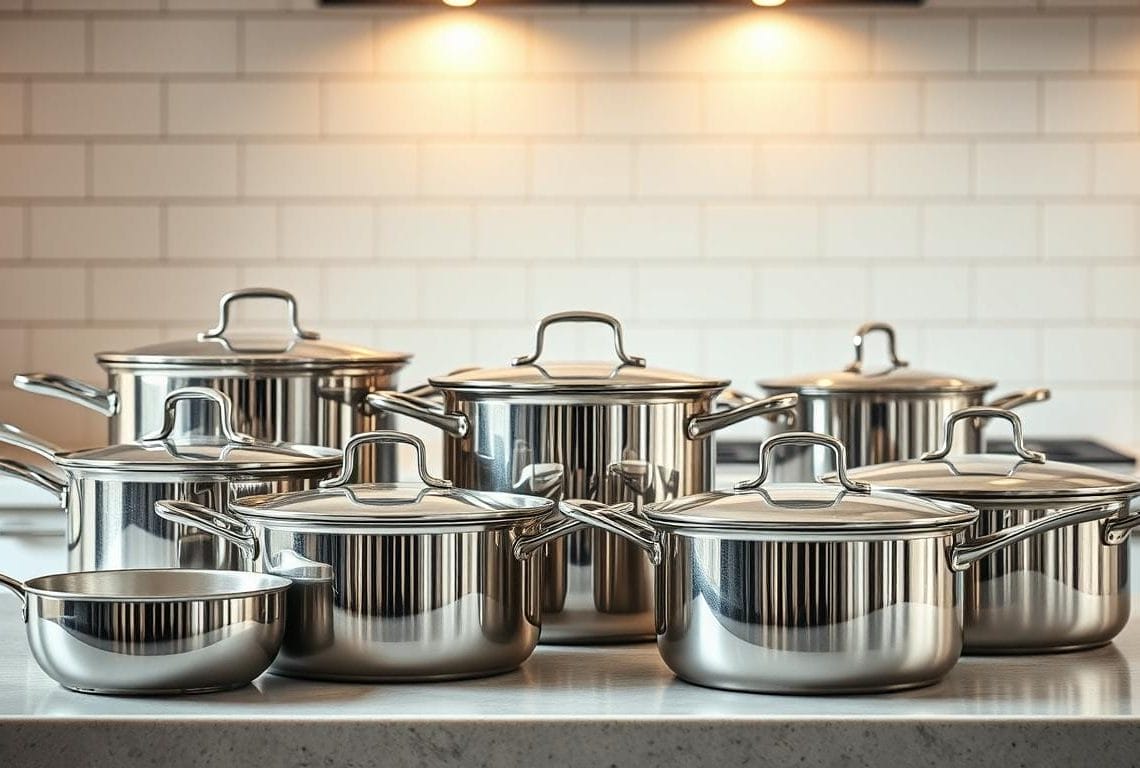
Must-haves: skillet, saucepan, stockpot — when to add a sauté pan
Add a sauté pan or braiser when you need extra surface and taller walls for larger batches, shallow braises, or family-sized sautés. A sauté pan gives more surface per piece than a saucepan and keeps sauces contained better than a skillet.
Why two different saucepan sizes improve everyday cooking
Two saucepans—one smaller (1.5–2 qt) and one larger (3 qt)—provide real flexibility.
- Small saucepan: grains, reheating, quick sauces.
- Large saucepan: reductions, pasta sauces, soups.
- Different geometries—squat vs. tall—help specific tasks. All‑Clad’s two shapes illustrate the benefit.
Practical details: prefer metal lids for oven work, look for helper handles on heavy pieces, and check base diameter—wider bases give more browning per batch. Plan an 8‑quart stockpot for pasta nights to avoid boil‑overs.
Budget approach: upgrade the skillet first if you cook daily, then add a saucepan and stockpot, or buy a well-curated 7‑piece set to get matched lids and consistent performance at a sensible price.
Other Pans We Tested and Liked
A handful of other pans stood out in testing for unique strengths and clear tradeoffs.
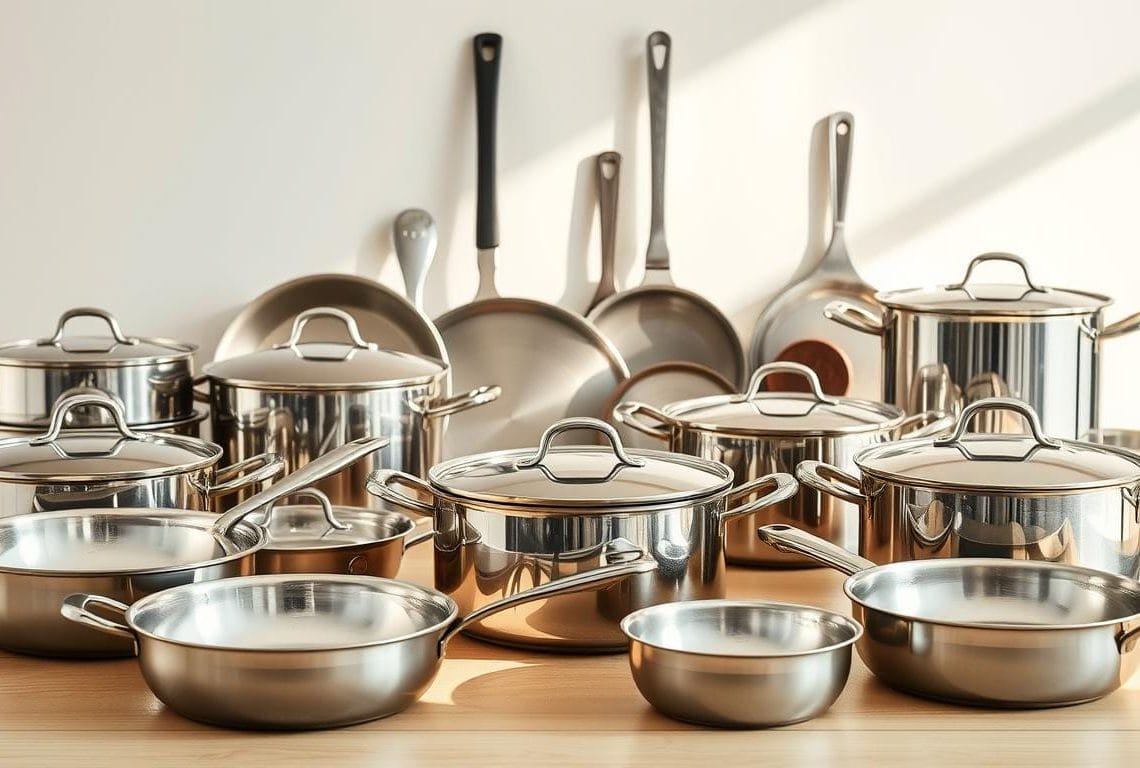
Fissler Pro-Ply
Pros: exceptional heat distribution and sidewall warmth help high-heat work and reduce scorching risk.
Cons: heavier heft and a higher price—best for cooks who value even performance over lightness.
Made In
Pros: heated evenly and feels comfortable in hand; often matches All‑Clad performance at a lower price.
Cons: some pieces arrive without lids—factor this when sizing a set or total ownership.
Ninja EverClad
Pros: quick to temperature and strong value; a fine skillet if you want performance without premium cost.
Cons: slight center-hot bias in some fry pan tests—minor for most home kitchen uses.
Calphalon Classic
Pros: dependable, even heating with a generous surface area.
Cons: notably heavy—one-handed work can feel fatiguing for some users.
- Check lids, oven limits, and handle balance before buying a piece or a full set.
- If All‑Clad D3 is out of reach, trial a Made In or Ninja EverClad skillet as a smart-value test of preferences.
Models That Fell Short in Our Testing
Performance failures fall into clear buckets: uneven heating, awkward geometry, and durability issues. This short list flags models that gave consistent trouble in heat mapping, searing trials, or daily use.

Uneven heat or scorching
Several skillets showed central hot zones in flour and IR tests. The Hestan ProBond concentrated heat in the center, producing obvious hot spots and discoloration. Anolon Tri-Ply and Zwilling Spirit also showed uneven readings and streaked browning.
Cleaning and comfort issues
Some brands made cleanup and handling harder. Quince, Misen, and Oxo held residue and had thin, uncomfortable handles that dig into the hand. These ergonomic issues slow prep and make frequent use fatiguing.
Budget pitfalls and durability
Watch geometry and build on low-price sets: Tramontina’s steep sides reduce usable surface area and crowd proteins. Cuisinart MultiClad Pro warped under high heat, causing wobble on flat tops and induction ranges.
- Partial cladding: Chef Classic’s thin rim promoted burning near the edge.
- Finish problems: some pieces discolored or stained quickly under intense heat.
- Ergonomics: heavy builds or awkward handles reduce everyday comfort.
Decision guide: if you sear often, avoid models with recorded warping or heat concentration. For reliable daily performance, choose true tri-ply construction and verified warp resistance. Learn more in our relevant guide.
Heat, Hot Spots, and Surface Area: What Our Data Shows
Tested temperature behavior predicts cooking outcomes: premium tri-ply pans like All‑Clad D3 tightened their across surface heat spread during preheat. That thermal stabilization reduces variance and yields more predictable results at the stove.
All‑Clad vs budget swings
All‑Clad’s spread narrowed as it warmed. Budget pans trended the opposite: Tramontina developed growing hot spots with a 22° swing in trials.
Practical effects on searing and caramelizing
Even heat produces a consistent crust across a steak. Hot centers and cooler edges create scorched bands and pale patches. In onion tests, even pans caramelized uniformly; uneven pans demanded constant stirring and repositioning.
- Batch efficiency: larger, flatter surface area expands usable browning zone and keeps moisture down.
- Pan sauces: uniform fond forms and releases cleanly, improving deglazes and reducing bitter notes.
- Mitigation: rotate food or reposition burners for uneven pans—but this is a workaround, not a fix.
IR mapping at center and edges over time revealed which models stabilized and which drifted. For repeatable results across a set, choose pieces with narrowing, stable heat distribution.
Induction, Oven Safety, and Everyday Durability
Check range compatibility and oven limits before you commit to a full set—these specs determine long-term usefulness. Choosing the right materials and lids prevents surprises when searing, broiling, or finishing dishes in the oven.
Induction-ready clad stainless vs copper-clad limits
Most clad stainless exteriors with magnetic alloys work on induction. That makes them future-proof if you switch ranges.
Copper-clad sets often lack magnetic bases and therefore won’t run on induction. Serious Eats found many copper-clad lines cap oven use near 450°F.
Oven ceilings, handles, and daily wear
All‑Clad D3 is rated to 600°F; Goldilocks skillets to about 550°F. Glass lids typically limit oven temps to roughly 350–375°F, while metal lids give full flexibility.
- Heat control: clad stainless pairs well with induction for fast, precise heat when making sauces or searing.
- Handle comfort: metal handles conduct heat—use mitts and choose pieces with helper grips for heavy pans.
- Durability: tri-ply construction resists warping and cleans up with routine hand-washing.
Buying tip: if a range change is possible, pick induction-compatible sets now to avoid replacing a valuable set later.
Discoloration, Patina, and Cleaning Tips
Heat and oil leave visible traces on metal, but most color shifts are harmless and reversible. A rainbow tinge or bronzing usually comes from high heat or oil residues—not a food-safety issue.
Why rainbow tinge and bronzing appear—and when it’s cosmetic
Cause: Rapid heat exposure or polymerized oils form thin oxide layers that refract light into rainbow colors.
When to worry: If the surface pits, flakes, or smells off, stop using that piece. Otherwise, the patina is cosmetic and won’t affect food.
Best practices: hand-washing, Bar Keepers Friend, and avoiding harsh detergents
After use, let pans cool briefly. Hand-wash with warm soapy water and a nonabrasive sponge.
- For stuck-on bits: simmer water with a dash of baking soda, scrape gently with a silicone spatula, then rinse.
- For persistent stains: apply a paste of Bar Keepers Friend and water briefly, scrub lightly, then rinse to restore the surface.
- Protect finish: avoid frequent dishwasher cycles—strong detergents can dull a finish and roughen edges over years.
- Lid care: metal lids follow the same routine; don’t expose lower-temp glass lids to broilers or extreme oven heat.
Practical note: Budget pans show color shifts sooner; premium stainless steel often resists staining during identical tests. Consistent hand-washing and prompt cleanup keep a set or single piece looking sharp and make routine maintenance quick.
Best Budget Paths: Low Price Without Big Compromises
Smart low-price picks focus on real performance—flat bases, full cladding, and useful sizes.
Choose a compact cookware set that emphasizes construction over extras. Look for fully clad, tri-ply builds at budget tiers and avoid disc-only bases that create hot spots. Brands such as Goldilocks and Ninja EverClad deliver strong value—expect minor center bias on some models but solid real-world results.
Accept tradeoffs deliberately: glass lids limit oven use, lighter handles may feel unbalanced, and lower-price finishes stain sooner. These are manageable with hand-washing and occasional Bar Keepers Friend.
Practical buying checklist
- Prioritize: fully clad pans and wide skillet bases over extra pots you won’t use.
- Verify size: ensure the stockpot is true 8 qt and the skillet base is broad enough for searing.
- Handle comfort: rounded grips and helper handles matter when pans are full.
- Upgrade path: pair a budget set with one premium skillet to boost searing without blowing the price.
Final note: compare the total price against what you will actually use—sets that cut corners in construction cost more in frustration than in dollars.
Ready to Cook Better: Choose Your Pan, Set Your Budget, Start Searing
Decide now whether a single high-performing skillet or a matched set best matches your weekly cooking habits.
Quick path: buy one standout pan if you cook alone or on weeknights. Choose a full set if you want matched lids and consistent performance across pots and pans for family meals.
Anchor on reliability: premium tri-ply pieces like All‑Clad D3 deliver even heat and last for years. For a budget route, pick a Goldilocks-style essentials set now and upgrade the most-used piece later.
Checklist before buying: full cladding, induction/oven compatibility, comfortable handles, tight lids, and a wide flat base. Hand-wash, spot with Bar Keepers Friend, and preheat deliberately to protect finish and performance.
Set a budget, choose your path, and start searing with gear that earns its price by saving time and replacements.

